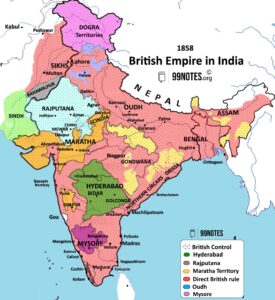24 February 2024 : The Hindu Editorial Notes PDF
The Hindu Editorial
24-February-2024
1. Courts must act against governments issuing blocking orders on social media content
| Topic: GS2 – Indian Polity – Judiciary GS2 – Governance – Important aspects of governance – Transparency and accountabilityUPSC candidates need to grasp the significance as it involves democratic values, governance challenges, and free speech implications in India. |
| Context |
|
Introduction:
- Internet shutdowns and curbs on free speech via social media are increasingly employed by those in power.
- Recent instances in Haryana, Rajasthan, and at the national level in India highlight arbitrary use of such measures against farmer protests.
Arbitrary Internet Shutdowns:
- Bharatiya Janata Party-led State governments of Haryana and Rajasthan employed Internet shutdowns without clear justification.
- Shutdowns lacked adequate cause, using vague reasons related to potential law and order breakdown.
- Actions failed proportionality tests outlined by the Supreme Court in Anuradha Bhasin vs Union of India case.
Union Government’s Social Media Control:
- Union government issued notices to social media companies, including X (formerly Twitter), to block accounts without transparent reasons.
- X previously challenged blocking orders during 2020-21 farmer protests, indicating resistance to blanket blocking without clear grounds.
- X, under Elon Musk’s ownership, stopped publishing transparency reports, eliminating insight into legal requests from Indian state agencies.
Elon Musk’s Influence on X:
- Post Elon Musk’s takeover, X shifted from a platform promoting free speech and discussion to aligning with owner’s views and business interests.
- X’s decision to withhold flagged content without disagreement signalled a departure from being a thriving platform for free speech.
Karnataka High Court’s Troubling Judgment:
- Karnataka High Court’s judgment dismissed X’s petition challenging blocking orders during farmer protests.
- Single-judge decision granted government authorities wide discretion in issuing content blocking orders without providing notices or valid reasoning.
- X’s ongoing appeal in the High Court aims to clarify social media companies’ rights and obligations regarding content on their platforms.
Government’s Indifference to Democratic Values:
- Government actions raise concerns about the impact on India’s reputation as a free, open, and democratic society.
- Lack of government concern suggests a disregard for the implications of such actions on the country’s global standing and social media companies’ operations.
Conclusion:
- The situation underscores the need for clarity on the rights and obligations of social media platforms in India.
- X’s appeal in the Karnataka High Court is crucial in defining the boundaries between government authority and free speech on digital platforms.
| Internet Shutdowns and Implications On Free Speech |
Instances of Internet Shutdowns in India:
Implications of Internet Shutdowns on Free Speech:
Way Forward:
|
| PYQ: Use of Internet and social media by non-state actors for subversive activities is a major concern. How these have misused in the recent past? Suggest effective guidelines to curb the above threat. (200 words/12.5m) (UPSC CSE (M) GS-3 2016) |
| Practice Question: Discuss the impact of internet shutdowns on freedom of speech and their implications on society. Suggest effective strategies for governments to balance security concerns with the protection of fundamental rights. (250 words/15 m) |
2. Changing the growth paradigm
| Topic: GS3 – Indian Economy – Inclusive growth, Issues relating to development and employment GS2 – Governance – Government policies Critical for UPSC as it addresses India’s economic model flaws, inequality, climate concerns, urging holistic, sustainable solutions. |
| Context |
|
The Governor’s Concerns: India’s Economic Health and GDP Growth
- The Governor of the Reserve Bank of India expresses concern about the Indian economy’s health in an open letter to the Finance Minister.
- Emphasizes that increased GDP doesn’t necessarily improve citizens’ well-being if income distribution remains unequal.
- Highlights the failure of the Indian economy to provide decent jobs despite impressive GDP growth.
Critique of GDP as a Sole Indicator
- Questions the prevailing emphasis on GDP growth as the primary measure of economic health.
- Argues that the focus on increasing the size of the economic pie before redistribution has led to growing inequality.
- Notes the lack of consensus among economists on measuring citizen well-being, poverty, employment, and adequate income.
Inequitable Growth and Flawed Development Model
- Highlights that India is becoming one of the most unequal countries globally due to a flawed model of economic progress.
- Points out that regardless of the political party in power, successive Indian governments have prioritized GDP growth since 1991.
- Indicates that structural conditions causing inequitable growth have not improved and, in fact, have worsened over time.
Inclusive and Sustainable Development
- Discusses the global paradigm of economic development, which typically involves a progression from agriculture to industry and then to services.
- Challenges the “one path for all” model that views villages and farms negatively, advocating for a more inclusive and sustainable approach.
- Acknowledges the need for India to address the global climate crisis while pursuing economic growth.
The Role of Fossil Fuels in Modern Economy
- Identifies steel, concrete, plastics, and food production as dependent on fossil fuels, with alternatives in the pipeline but requiring significant time for implementation.
- Emphasizes the integral role of fossil fuels in the production and distribution of food to meet the needs of the growing global population.
Local Solutions and Systems Thinking
- Advocates for local systems solutions developed cooperatively by communities as a way to address global systemic problems.
- Cites the Gandhian solution for India’s economic and social progress, suggesting a return to local solutions and community-driven development.
- Urges policymakers to free themselves from Western-dominated economic theories and emphasizes the potential for rural India to lead in innovations for inclusive and sustainable growth.
Conclusion and Call for Paradigm Shift
- The letter by the RBI Governor stresses the need for a paradigm shift in India’s economic development approach.
- Urges a departure from Western-dominated economic theories and a return to local, community-driven solutions for inclusive and sustainable growth.
- Proposes rural Bharat as a potential source of innovations in institutions and policies for the benefit of the world.
| Critique of GDP as a Primary Economic Indicator |
Way Forward:
|
| PYQ: What are the salient features of ‘inclusive growth’? Has India been experiencing such a growth process? Analyze and suggest measures for inclusive growth. (250 words/15m) (UPSC CSE (M) GS-3 2017) |
| Practice Question: In the context of India’s economic development, discuss the limitations of the GDP-centric approach and propose alternative strategies for inclusive and sustainable growth. (250 words/15 m) |
3. The NB8 visit to India focuses on cooperation and trust.
| Topic: GS2 – International Relations The Nordic-Baltic cooperation’s engagement in Raisina Dialogue signifies global partnerships, economic dynamics, and strategic collaboration with India, relevant for UPSC. |
| Context |
|
Introduction:
- The Nordic-Baltic cooperation, comprising Denmark, Estonia, Finland, Iceland, Latvia, Lithuania, Norway, and Sweden, is actively participating in the Raisina Dialogue in New Delhi.
- The NB8 nations share deep historical, social, economic, and cultural ties, with advanced, outward-looking, and innovation-driven economies.
- These countries are fully integrated into the European Common Market, and their combined economic size qualifies them for not only the G-20 but also the G-10.
Common Values and Commitments:
- The Nordic-Baltic countries are bound by a commitment to democracy and human rights, advocating for an international order based on multilateralism and adherence to international law.
- They serve as champions of a rules-based global system, reflecting shared values that underpin their cooperation.
Diverse Areas of Collaboration:
- The cooperation between the Nordic-Baltic region and India spans a multitude of fields, showcasing the breadth of their engagement.
- Collaboration includes areas such as innovation, green transition, maritime affairs, health, intellectual property rights, new technologies, space cooperation, artificial intelligence, student exchanges, culture, and tourism.
Economic Integration and Potential:
- The Nordic-Baltic economies are fully integrated into the European Common Market, reflecting their economic prowess.
- The combined size of these economies not only qualifies them for the G-20 but also positions them favourably within the G-10, emphasizing their economic significance on the global stage.
Increasing Trade and Investment:
- Trade and investment figures between the Nordic-Baltic region and India are on a steady rise, indicating a deepening economic engagement.
- This trend reflects the mutual benefits derived from their collaboration and the potential for further economic integration.
Interconnected Regions:
- The Nordic-Baltic region and the Indo-Pacific are interconnected, emphasizing the importance of collaborative efforts to uphold international law and address both traditional and non-traditional security threats.
- Working together becomes essential to navigate shared challenges and contribute to global peace and stability.
Support for Ukraine and Global Implications:
- The ongoing war in Ukraine has far-reaching global implications, impacting food and energy security, supply chains, macro-financial stability, inflation, and overall economic growth.
- The Nordic-Baltic countries express support for Ukraine’s diplomatic efforts for peace, welcoming the involvement of an increasing number of countries and international organizations in peace formula meetings.
Objective of the Visit to India:
- The primary objective of the Nordic-Baltic countries’ visit to India is to foster increased dialogue and cooperation on issues that dominate India’s and other global partners’ agendas.
- This underlines the commitment to deepening ties and addressing shared challenges through collaborative efforts on a global scale.
Conclusion:
- The Nordic-Baltic cooperation’s active participation in the Raisina Dialogue reflects a commitment to shared values, economic integration, and addressing global challenges.
- The diverse areas of collaboration with India underscore the multifaceted nature of their partnership, emphasizing the potential for further growth and mutual benefits in the future.
| Practice Question: Examine the significance of the Nordic-Baltic cooperation’s collaboration with India in addressing shared challenges and fostering economic integration on the global stage. (150 words/10 m) |
For Enquiry

24 February 2024 : The Hindu Editorial Notes PDF

24 Feb 2024 : Indian Express Editorial Analysis

24 February 2024 : PIB Summary for UPSC

23 Feb 2024 : Daily Current Affairs Quiz

23 Feb 2024 : Daily Answer Writing

23 Feb 2024 : Daily Current Affairs

23 February 2024 : The Hindu Editorial Notes PDF

23 February 2024 : PIB Summary for UPSC

23 Feb 2024 : Indian Express Editorial Analysis

Annexation of Sindh & Punjab by British- Complete Notes for UPSC
Feb 2024 The Hindu 24 February 2024 : The Hindu Editorial Notes PDF The Hindu Editorial
24-February-2024
1. Courts must act against governments issuing blocking orders…
Indian Express 24 Feb 2024 : Indian Express Editorial Analysis Indian Express Editorial Analysis
24-February-2024
1. A war of attrition
Topic: GS2 – International…
feb 2024 PIB 24 February 2024 : PIB Summary for UPSC PIB Summary for UPSC
24 February -2024
1. President’s greetings on the eve of birth anniversary…
Daily Quiz 23 Feb 2024 : Daily Current Affairs Quiz 23 Feb 2024 : Daily Quiz…
mains answer writing 23 Feb 2024 : Daily Answer Writing Mains Answer Writing
23-February-2024
Q1) Though President of India is the constitutional head of the…
Daily Current Affairs 23 Feb 2024 : Daily Current Affairs Daily Current Affairs
23-February-2024- Top News of the Day
1. Escalating Farmer Protests: Challenges…
Feb 2024 The Hindu 23 February 2024 : The Hindu Editorial Notes PDF The Hindu Editorial
23-February-2024
1. The government must keep the regulatory environment of space…
feb 2024 PIB 23 February 2024 : PIB Summary for UPSC PIB Summary for UPSC
23 February -2024
1. With a focus on promotion of organic exports, APEDA forms…
Indian Express 23 Feb 2024 : Indian Express Editorial Analysis Indian Express Editorial Analysis
23-February-2024
1. A long institutional road
Topic: GS2 – Polity…
Modern India Annexation of Sindh & Punjab by British- Complete Notes for UPSC Annexation of Sindh & Punjab by British
By 1818, the entire Indian subcontinent, except Punjab and…


